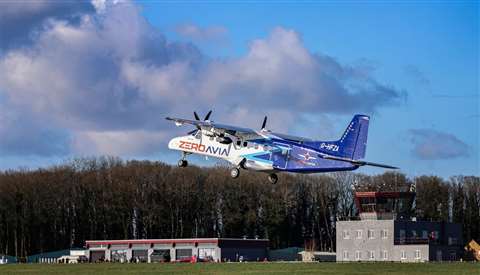ZeroAvia successfully tests hydrogen-electric aircraft engine
20 January 2023
 Take off of the ZeroAvia test flight with the H2-electric engine (Photo: ZeroAvia)
Take off of the ZeroAvia test flight with the H2-electric engine (Photo: ZeroAvia)
ZeroAvia, a specialist company which is investigating the development of hydrogen-electric aviation solutions, has reported that it has successfully completed the first test flight of the world’s largest aircraft powered by an H2-electric engine.
The flight was completed by a 19-seat Dornier 228, retrofitted with a full-size prototype hydrogen electric powertrain on the left wing of the aircraft. On the right wing, the aircraft used a stock Honeywell TPE-331 engine.
The aircraft took off from the company’s R&D facility at Cotswold Airport in the west of England and completed a 10-minute flight. The test is part of the HyFlyer II project, an R&D programme with backing from the UK government’s Aerospace Technology Institute (ATI) programme (which is supported by the Department for Business, Energy and Industrial Strategy and Innovate UK). This targets development of a 600 kW powertrain to support nine- to 19-seat aircraft achieving zero-emission flight.
The HyFlyer II project will be concluded with a planned 300-nautical mile test flight, to be completed over 2023.
The ZeroAvia H2-electric powertrain features two fuel cell stacks and li-ion battery packs to support power delivery during take off and to also add power during safety testing. For this test flight, H2 tanks and fuel cell systems were located within the aircraft. In commercial configuration the hardware would be located externally.
The test flight was operated under a full Part 21 flight permit with the UK Civil Aviation Authority, a more stringent set of requirements compared to those of the E-Conditions framework under which ZeroAvia has flown previous tests. With all systems performing as expected, the company is now on track to a certifiable configuration which will be finalised and submitted for certification over this year. It is hoped a certifiable configuration will support commercial routes by 2025.
“This is a major moment, not just for ZeroAvia, but for the aviation industry as a whole, as it shows that true zero-emission commercial flight is only a few year away,” said Val Miftakhov, founder and CEO. “The first flight of our 19-seat aircraft shows just how scalable our technology is and highlights the rapid progress of zero-emission propulsion.”
Moving forward, ZeroAvia’s 2-5 MW powertrain programme will scale the clean engine technology for up to 90-seat aircraft, with further expansion into narrow-body aircraft.
STAY CONNECTED




Receive the information you need when you need it through our world-leading magazines, newsletters and daily briefings.
POWER SOURCING GUIDE
The trusted reference and buyer’s guide for 83 years
The original “desktop search engine,” guiding nearly 10,000 users in more than 90 countries it is the primary reference for specifications and details on all the components that go into engine systems.
Visit Now
CONNECT WITH THE TEAM










